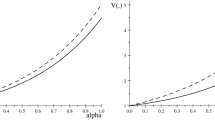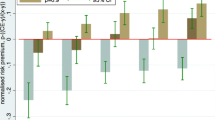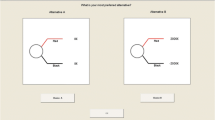Abstract
In this paper, we investigate the necessary and sufficient conditions for a decision maker to be monotone risk averse and left-monotone risk averse, respectively, in cumulative prospect theory (CPT). Our results show that the decision maker is more pessimistic than greedy if she is either monotone or left-monotone risk averse, which is similar to that of Chateauneuf et al. (Econ Theory 25(3):649–667, 2005) in the rank-dependent expected utility model. Detailed examples are presented to illustrate the main theorems. With this work, we make a progress in the characterizations of risk aversion in CPT, which is essential in understanding the features of CPT and its applications in finance and insurance.

Similar content being viewed by others
References
Arrow, K.J.: The Theory of Risk Aversion. Essays in the theory of risk-bearing, pp. 90–120 (1971)
Barberis, N.C.: Thirty years of prospect theory in economics: a review and assessment. J. Econ. Perspect. 27(1), 173–195 (2013)
Bickel, P., Lehmann, E.: Descriptive statistics for non-parametric model iv: spread. In: Juresckova, J. (ed.) Contributions to Statistics. Reidel, Amsterdam (1979)
Birnbaum, M.H.: Causes of allais common consequence paradoxes: an experimental dissection. J. Math. Psychol. 48(2), 87–106 (2004)
Birnbaum, M.H.: Three new tests of independence that differentiate models of risky decision making. Manag. Sci. 51(9), 1346–1358 (2005)
Birnbaum, M.H., Bahra, J.P.: Gain-loss separability and coalescing in risky decision making. Manag. Sci. 53(6), 1016–1028 (2007)
Chateauneuf, A., Cohen, M.: Risk seeking with diminishing marginal utility in a non-expected utility model. J. Risk Uncertain. 9(1), 77–91 (1994)
Chateauneuf, A., Cohen, M., Meilijson, I.: Four notions of mean-preserving increase in risk, risk attitudes and applications to the rank-dependent expected utility model. J. Math. Econo. 40(5), 547–571 (2004)
Chateauneuf, A., Cohen, M., Meilijson, I.: More pessimism than greediness: a characterization of monotone risk aversion in the rank-dependent expected utility model. Econ. Theory 25(3), 649–667 (2005)
Chateauneuf, A., Cohen, M., Vergnaud, J.: Left-monotone reduction of risk, deductible and call. Technical report, Mimeo (2001)
Chateauneuf, A., Wakker, P.: An axiomatization of cumulative prospect theory for decision under risk. J. Risk Uncertain. 18(2), 137–145 (1999)
Diamond, P.A., Stiglitz, J.E.: Increases in risk and in risk aversion. J. Econ. Theory 8(3), 337–360 (1974)
Gollier, C., Schlesinger, H.: Arrow’s theorem on the optimality of deductibles: a stochastic dominance approach. Econ. Theory 7(2), 359–363 (1996)
Hong, C.S., Karni, E., Safra, Z.: Risk aversion in the theory of expected utility with rank dependent probabilities. J. Econo. Theory 42(2), 370–381 (1987)
Jewitt, I.: Choosing between risky prospects: the characterization of comparative statics results, and location independent risk. Manag. Sci. 35(1), 60–70 (1989)
Kahneman, D., Tversky, A.: Prospect theory: An analysis of decision under risk. Econom. J. Econom. Soc. 263–291 (1979)
Landsberger, M., Meilijson, I.: Co-monotone allocations, Bickel–Lehmann dispersion and the arrow-pratt measure of risk aversion. Ann. Oper. Res. 52(2), 97–106 (1994)
Landsberger, M., Meilijson, I.: The generating process and an extension of Jewitt’s location independent risk concept. Manag. Sci. 40(5), 662–669 (1994)
Mao, T., Hu, T.: Characterization of left-monotone risk aversion in the rdeu model. Insur. Math. Econ. 50(3), 413–422 (2012)
Marley, A.A., Luce, R.D.: Independence properties vis-à-vis several utility representations. Theory Decis. 58(1), 77–143 (2005)
Müller, A.: Comparing risks with unbounded distributions. J. Math. Econ. 30(2), 229–239 (1998)
Müller, A., Stoyan, D.: Comparison Methods for Stochastic Models and Risks. Wiley, Chichester (2002)
Neilson, W.S.: Calibration results for rank-dependent expected utility. Econ. Bull. 4(10), 1–5 (2001)
Pratt, J.W.: Risk aversion in the small and in the large. Econom. J. Econom. Soc. 32, 122–136 (1964)
Quiggin, J.: A theory of anticipated utility. J. Econ. Behav. Organ. 3(4), 323–343 (1982)
Quiggin, J.: Generalized Expected Utility Theory: The Rank-dependent Model. Springer, Berlin (2012)
Rabin, M.: Risk aversion and expected-utility theory: A calibration theorem. Econometrica: Journal of the Econometric Society 68(5), 1281–1292 (2000)
Rabin, M., Thaler, R.H.: Anomalies: risk aversion. J. Econ. Perspect. 15(1), 219–232 (2001)
Ryan, M.J.: Risk aversion in rdeu. J. Math. Econ. 42(6), 675–697 (2006)
Schmeidler, D.: Subjective probability and expected utility without additivity. Econom. J. Econom. Soc. pp. 571–587 (1989)
Schmidt, U., Zank, H.: Linear cumulative prospect theory with applications to portfolio selection and insurance demand. Decis. Econ. Finance 30(1), 1–18 (2007)
Schmidt, U., Zank, H.: Risk aversion in cumulative prospect theory. Manag. Sci. 54(1), 208–216 (2008)
Shaked, M., Shanthikumar, G.: Stochastic Orders. Springer, Berlin (2007)
Starmer, C., Sugden, R.: Violations of the independence axion in common ratio problems: an experimental test of some competing hypotheses. Ann. Oper. Res. 19(1), 79–102 (1989)
Stiglitz, J.E., Rothschild, M.: Increasing risk: I. A definition. J. Econ. Theory 2(3), 225–243 (1970)
Tversky, A., Kahneman, D.: Advances in prospect theory: cumulative representation of uncertainty. J. Risk Uncertain. 5(4), 297–323 (1992)
Wakker, P., Tversky, A.: An axiomatization of cumulative prospect theory. J. Risk Uncertain. 7(2), 147–175 (1993)
Wakker, P.P., Zank, H.: A simple preference foundation of cumulative prospect theory with power utility. Eur. Econ. Rev. 46(7), 1253–1271 (2002)
Wu, G., Markle, A.B.: An empirical test of gain-loss separability in prospect theory. Manag. Sci. 54(7), 1322–1335 (2008)
Yaari, M.E.: The dual theory of choice under risk. Econ. J. Econ. Soc. 95–115 (1987)
Acknowledgements
Supports for Tiantian Mao from the NNSF of China (Grant Numbers: 71671176, 71871208, 11501575) are gratefully acknowledged. Support for Fan Yang from grant from the Natural Sciences and Engineering Research Council of Canada (Grant Number: 04242) is gratefully acknowledged.
Author information
Authors and Affiliations
Corresponding author
Appendix
Appendix
In the appendix, we first prove the relation (3.6), and then prove Theorems 3.1 and 4.1.
Proof of (3.6)
Denote \(G_u^*:=\sup _{y\leqslant 0\leqslant x} \max \{RG_u^{+}(x),\,G_u^{+}(x),\,G_u^{-}(y)\}.\) To show the equation (3.6), it suffices to show that \(G_{u}\leqslant G_u^*\). From the definition of \(G_{u}\), for any \(\varepsilon >0\), there exist \(x_{1}<x_{2}\leqslant y_{1}<y_{2}\) such that
Next we consider the following five cases.
-
(i)
If \(x_1\geqslant 0\), then \(G_u^*\geqslant G_u^{+}(y_1)\geqslant g_0>G_u-\varepsilon \).
-
(ii)
If \(x_{1}< 0 < x_{2}\), note that
$$\begin{aligned} \frac{u(x_2)-u(x_1)}{x_2-x_1} = \lambda \frac{u(x_2)-u(0)}{x_2}+(1-\lambda ) \frac{u(0)-u(x_1)}{-x_1} \end{aligned}$$with \(\lambda =x_2/(x_2-x_1)\in (0,1)\). Then at least one of \({(u(x_2)-u(0))}/{x_2}\) and \({(u(0)-u(x_1))}/{(-x_1)}\) is no larger than \({(u(x_2)-u(x_1))}/{(x_2-x_1)}\). If \({(u(x_2)-u(0))}/{x_2}\leqslant {(u(x_2)-u(x_1))}/{(x_2-x_1)}\), then
$$\begin{aligned} G_u^*\geqslant G_u^+(y_1)\geqslant \frac{(u(y_2)-u(y_1))/(y_2-y_1)}{(u(x_2)-u(0))/x_2}\geqslant g_0>G_u-\varepsilon . \end{aligned}$$Otherwise, \({(u(0)-u(x_1))}/{(-x_1)}\leqslant {(u(x_2)-u(x_1))}/{(x_2-x_1)}\), then
$$\begin{aligned} G_u^* \geqslant RG_u^+(y_1)\geqslant \frac{(u(y_2)-u(y_1))/(y_2-y_1)}{{(u(0)-u(x_1))}/{(-x_1)}}\geqslant g_0>G_u-\varepsilon . \end{aligned}$$ -
(iii)
If \(x_{2}\leqslant 0\leqslant y_{1}\), then \(G_u^*\geqslant RG^+(y_1)\geqslant g_0>G_u-\varepsilon \).
-
(iv)
If \( y_{1}<0<y_{2}\), similar to (ii), one can show \(G_u^*>G_u-\varepsilon \).
-
(v)
If \(y_2\leqslant 0\), then \(G_u^*\geqslant G_u^{-}(x_2)\geqslant g_0>G_u-\varepsilon \).
Combining the above five cases, we have that \(G_u^*>G_u-\varepsilon \) for any \(\varepsilon >0\), and hence, \(G_u^*\geqslant G_u\). This completes the proof. \(\square \)
Next, we prove Theorems 3.1 and 4.1 in the following. We point out that the proofs are similar to Chateauneuf et al. [9] but much more complicated and technical. The proof of sufficiency involves two steps: first for random variables with finitely many values, and then using a continuity argument to extend sufficiency of the condition to random variables in general.
Proof of Theorem 3.1
Sufficiency.
-
The discrete case. Noticing the relationship between the dispersive order and the mean-preserving out-stretch for random variables with finite outcomes, it suffices to show that \(V_{u,h_1,h_2}\) preserves any one mean-preserving out-stretch. Let X and Y be two random variables with cumulative distribution functions supported on finite sets such that Y is a mean-preserving out-stretch of X with \((a,b,\alpha )\). Note that Y can be obtained from X through m mean-preserving out-stretches of X with \((a/m,b/m,\alpha )\). Hence, it suffices to show that \(V_{u,h_1,h_2}\) preserves any one mean-preserving out-stretch \((a,b,\alpha )\) for \(a,\,b>0\) small enough. Without loss of generality, let the probability mass functions of X and Y be given in Example 2.1 such that \(x_i\) and \(x_i-a\) have the same sign for \(i=1,\ldots ,k\) and \(x_j\) and \(x_j+b\) have the same sign for \(j=k,\ldots ,n\). Let \(r\in \{1,\ldots ,n\}\) satisfy that \(x_r\leqslant 0< x_{r+1}\). Considering this, three cases arise.
-
(a)
\(k>r\). Denote \(\Delta V= V_{u,h_1,h_2}(X)-V_{u,h_1,h_2}(Y)\). It holds that
$$\begin{aligned} \Delta V= & {} \sum _{i=1}^r (u(x_i) -u(x_{i}-a)) (h_2(p_i)-h_2(p_{i-1})) \\&+\, \sum _{i=r+1}^{k-1}(u(x_i) -u(x_{i}-a)) (h_1(1-p_{i-1})-h_1(1-p_i))\\&+ \,(u(x_k) -u(x_{k}-a)) (h_1(1-p_{k-1})-h_1(1-\alpha ))\\&- (u(x_k+b) -u(x_{k}))(h_1(1-\alpha )-h_1(1-p_k))\\&- \sum _{i=k+1}^n (u(x_i+b) -u(x_{i})) (h_1(1-p_{i-1})-h_1(1-p_i)). \end{aligned}$$Take \(u(x_{i_0}) - u(x_{i_0}-a) = \min _{1\leqslant i\leqslant r}\{u(x_i) - u(x_{i}-a)\}\), \(u(x_{i_1}) - u(x_{i_1}-a) = \min _{r+1\leqslant i\leqslant k}\{u(x_i) - u(x_{i}-a)\}\) and \(u(x_{j_0}+b) - u(x_{j_0}) = \max _{k\leqslant j\leqslant n}\{u(x_j+b) - u(x_{j})\}\). It follows that
$$\begin{aligned} \Delta V\geqslant & {} (u(x_{i_0}) - u(x_{i_0}-a)) h_2(p_r) +(u(x_{i_1}) - u(x_{i_1}-a)) (h_1(1-p_r)-h_1(1-\alpha )) \\&- (u(x_{j_0}+b) - u(x_{j_0}) ) h_1(1-\alpha )\\&{\mathop {=}\limits ^{\mathrm{sgn}}} \frac{u(x_{i_0}) - u(x_{i_0}-a)}{a}\frac{ h_2(p_r) }{\alpha } + \frac{u(x_{i_1}) - u(x_{i_1}-a)}{a} \frac{h_1(1-p_r)-h_1(1-\alpha )}{\alpha } \\&- \frac{u(x_{j_0}+b) - u(x_{j_0}) }{b} \frac{h_1(1-\alpha )}{1-\alpha }\\&{\mathop {=}\limits ^\mathrm{sgn}} \frac{(u(x_{i_0}) - u(x_{i_0}-a))/a}{(u(x_{j_0}+b) - u(x_{j_0}))/b} \cdot \frac{ h_2(p_r) / \alpha }{h_1(1-\alpha )/(1-\alpha )} \\&+ \frac{(u(x_{i_1}) - u(x_{i_1}-a))/a}{(u(x_{j_0}+b) - u(x_{j_0}))/b} \cdot \frac{(h_1(1-p_r)-h_1(1-\alpha ))/\alpha }{h_1(1-\alpha )/(1-\alpha )} - 1\\\geqslant & {} P_{p_r,1-\alpha }(h_1,h_2)/RG_u^{+}(x_{j_0}) + P_{p_r,1-\alpha }(h_1)/G_u^{+}(x_{j_0}) - 1, \end{aligned}$$where \(x{\mathop {=}\limits ^\mathrm{sgn}} y\) represents that x and y have the same sign and the second step follows from \(a\alpha =b(1-\alpha )\). From the second inequality in (3.9) we have that \(\Delta V\geqslant 0\).
-
(b)
\(r=k\). If \(x_{r}=0\), then \(\Delta V\) is expressed as the case in (a). If \(x_r<0\), we similarly define \(u(x_{i_0}) - u(x_{i_0}-a)=\min _{1\leqslant i\leqslant k}\{u(x_{i})-u(x_{i}-a) \}\) and \(u(x_{j_0}+b) - u(x_{j_0})=\max _{k\leqslant j\leqslant n}\{u(x_{j}+b)-u(x_{j})\}\). Then it holds that
$$\begin{aligned} \Delta V= & {} \sum _{i=1}^k (u(x_i) -u(x_{i}-a)) (h_2(p_i)-h_2(p_{i-1})) \\&+(u(x_{k})-u(x_{k}-a))(h_{2}(\alpha )-h_{2}(p_{k-1}))\\&-(u(x_{k}+b)-u(x_{k}))(h_{1}(1-\alpha )-h_{1}(1-p_{k})) \\&- \sum _{i=\ell +1}^n (u(x_i+b) -u(x_{i})) (h_1(1-p_{i-1})-h_1(1-p_i))\\\geqslant & {} (u(x_{i_0}) - u(x_{i_0}-a)) h_2(\alpha ) - (u(x_{j_0}+b) - u(x_{j_0}) ) h_1(1-\alpha )\\&{\mathop {=}\limits ^\mathrm{sgn}} \frac{\left( u(x_{i_{0}})-u(x_{i_{0}}-a)\right) /a}{(u(x_{j_{0}}+b)-u(x_{j_{0}}))/b} \cdot \frac{h_{2}(\alpha )/\alpha }{h_{1}(1-\alpha )/(1-\alpha )}-1\\\geqslant & {} P_{\alpha ,1-\alpha }(h_1,h_2)/RG_u^{+}(x_{j_0})-1\geqslant 0, \end{aligned}$$where the last inequality follows from the second inequality of (3.9) by noting that \(P_{\alpha ,1-\alpha }(h_1)=0\).
-
(c)
\(k<r\). This is similar to (a). Note that in this case
$$\begin{aligned} \Delta V =&\sum _{i=1}^{k-1}(u(x_{i})-u(x_{i}-a))(h_{2}(p_{i})-h_{2}(p_{i-1}))\\&+(u(x_{k})-u(x_{k}-a))(h_{2}(\alpha )-h_{2}(p_{k-1}))\\&-(u(x_{k}+b)-u(x_{k}))(h_{2}(p_{k})-h_{2}(\alpha ))\\&-\sum _{i=k+1}^{r}(u(x_{i}+b)-u(x_{i}))(h_{2}(p_{i})-h_{2}(p_{i-1}))\\&-\sum _{i=r+1}^{n}(u(x_{i}+b)-u(x_{i}))(h_{1}(1-p_{i-1})-h_{1}(1-p_{i})). \end{aligned}$$Similarly, denote \(u(x_{i_{0}})-u(x_{i_{0}}-a)=\min _{1\leqslant i\leqslant k}\{u(x_{i})-u(x_{i}-a)\},\)\(u(x_{j_{0}}+b)-u(x_{j_{0}})=\max _{k\leqslant j\leqslant r}\{u(x_{j}+b)-u(x_{j})\},\) and \(u(x_{j_{1}}+b)-u(x_{j_{1}})=\max _{r+1\leqslant j\leqslant n}\{u(x_{j}+b)-u(x_{j})\}.\) It follows from \(a\alpha =b(1-\alpha )\) that
$$\begin{aligned} \Delta V&\geqslant (u(x_{i_{0}})-u(x_{i_{0}}-a))h_{2}(\alpha )-(u(x_{j_{0}}+b)-u(x_{j_{0}}))\left( h_{2}(p_{r})-h_{2}(\alpha )\right) \\&\quad -(u(x_{j_{1}}+b)-u(x_{j_{1}}))h_{1}(1-p_{r})\\&\quad \overset{\mathrm {sgn}}{=}1-\frac{\left( u(x_{j_{0}}+b)-u(x_{j_{0}})\right) /b}{\left( u(x_{i_{0}})-u(x_{i_{0}}-a)\right) /a} \cdot \frac{\left( h_{2}(p_{r})-h_{2}(\alpha )\right) /(1-\alpha )}{h_{2}(\alpha )/\alpha }\\&\quad -\frac{(u(x_{j_{1}}+b)-u(x_{j_{1}}))/b}{\left( u(x_{i_{0}})-u(x_{i_{0}}-a)\right) /a}\cdot \frac{h_{1}(1-p_{r})/(1-\alpha )}{h_{2}(\alpha )/\alpha }\\&\geqslant 1- G_u^{-}(x_{i_0})P_{p_r,\alpha }(h_2) - RG_u^{-}(x_{i_0}) P_{p_r,\alpha }(h_2,h_1). \end{aligned}$$By the first inequality of (3.9), we have that \(\Delta V\geqslant 0\). This ends the proof of sufficiency for the discrete case.
-
(a)
-
The general case. Let X and Y be two general random variables such that \(X\prec _{\mathrm{disp}} Y\) and \(\mathbb {E}[X]=\mathbb {E}[Y]\). Then by Proposition 2.1, there exist two sequences of random variables \(\{X_n\}\) and \(\{Y_n\}\) each with finite support, such that (a) and (b) in Proposition 2.1 hold. By (a) and the proof of the discrete case, we have \(V_{u,h_1,h_2}(X_n)\geqslant V_{u,h_1,h_2}(Y_n)\) for \(n\in \mathbb {N}\). By (b), we have that \(V_{u,h_1,h_2}(X_n)\leqslant V_{u,h_1,h_2}(X)\). Note that \(Y-2^{-n}\leqslant Y_n\) for each \(n\geqslant 1\) and u is continuous. It follows that \(\lim _{n\rightarrow \infty } V_{u,h_1,h_2}(Y_n)=V_{u,h_1,h_2}(Y)\). Therefore, \(V_{u,h_1,h_2}(X)\geqslant V_{u,h_1,h_2}(Y)\). This completes the proof of sufficiency for the general case.
Necessity. Similar to the proof of necessity in Theorem 1 of Chateauneuf et al. [9], we show it by contradiction. We only give a proof for the second inequality of (3.9), the proof of the first one is similar. Assume that the second inequality of (3.9) does not hold, that is, there exist \({\alpha },\,p\geqslant 0\) with \({\alpha }+p\leqslant 1\) and \(y\geqslant 0\) such that
Then there exist \(x_1<x_2\leqslant 0\leqslant x_3< x_4\leqslant y< \min \{x_5, x_6\}\) such that
Without loss of generality, one can assume that \(x_5=x_6\). This is due to that if \((u(x_6) - u(y))/(x_6-y) <(u(x_5) - u(y))/(x_5-y)\), the inequality of (6.1) still holds by replacing \((u(x_6) - u(y))/(x_6-y)\) by \((u(x_5) - u(y))/(x_5-y)\), and vice versa. Note that for a continuous function u, for any \(z_1<z_2\), there exists \(\delta _0>0\) such that
It then follows that there exist \(x_1^*<x_2^*\leqslant 0\leqslant x_3^*< x_4^*\leqslant y^*< x_5^*\) with \(x_2^*-x_1^*=x_4^*-x_3^*\) and \((x_5^*-y^*)(1-\alpha )=(x_2^*-x_1^*)\alpha \) such that
We define two random variables X and Y such that

Then it can be verified that Y is a mean-preserving out-stretch \((x_2^*-x_1^*,x_5^*-y,\alpha )\) of X by Example 2.1, but \(V_{u,h_1,h_2}(X) < V_{u,h_1,h_2}(Y)\) by (6.2), which yields a contradiction with that \(V_{u,h_1,h_2}\) is monotone risk averse. This ends the proof. \(\square \)
Proof of Theorem 4.1
Sufficiency.
-
The discrete case. Let X and Y be two random variables with finite outcomes such that \(X\prec _{\mathrm{lir}}Y\). By Proposition 2.2, without loss of generality, we assume that X and Y are defined in Example 2.2, and, moreover, the special mean-preserving left-stretch between X and Y satisfies that \(s=1\) and \(a>0\) is small enough such that \(x_k-a\) and \(x_k\) have the same sign. Suppose that r is an integer such that \(x_{r}\leqslant 0<x_{r+1}\).
-
(a)
\(r\leqslant k\) and \(x_r< 0\). Denote \(\Delta V= V(X)-V(Y)\). It holds that
$$\begin{aligned} \Delta V= & {} \sum _{i=1}^r (u(x_i) -u(x_{i}-a)) (h_2(p_i)-h_2(p_{i-1})) \\&+ \sum _{i=r+1}^{k-1}(u(x_i) -u(x_{i}-a)) (h_1(1-p_{i-1})-h_1(1-p_i))\\&+\ (u(x_k)-u(x_k-a))(h_1(1-p_{k-1})-h_1(1-\alpha ))\\&-\ (u(x_{k+1})-u(x_k))(h_1(1-\alpha )-h_1(1-p_k)). \end{aligned}$$Let \(u(x_{i_0}) - u(x_{i_0}-a) = \min _{1\leqslant i\leqslant r}(u(x_i) - u(x_{i}-a))\) and \(u(x_{j_{0}})-u(x_{j_{0}}-a)=\min _{r+1\leqslant j\leqslant k}(u(x_{j})-u(x_{j}-a))\). It follows that
$$\begin{aligned}&\Delta V \geqslant (u(x_{i_0}) - u(x_{i_0}-a)) h_2(p_r) + (u(x_{j_0})\\&\quad - u(x_{j_0}-a))( h_1(1-p_r)-h_1(1-\alpha )) \\&\quad - (u(x_{k+1}) - u(x_{k}) ) (h_1(1-\alpha )-h_1(1-p_k))\\&\quad {\mathop {=}\limits ^\mathrm{sgn}} \frac{u(x_{i_0}) - u(x_{i_0}-a)}{a} \cdot \frac{h_2(p_r)}{\alpha } + \frac{u(x_{j_0}) - u(x_{j_0}-a)}{a} \\&\quad \cdot \frac{ h_1(1-p_r)-h_1(1-\alpha )}{\alpha }\\&\quad - \frac{u(x_{k+1}) - u(x_{k})}{x_{k+1}-x_k} \cdot \frac{h_1(1-\alpha )-h_1(1-p_k)}{p_k-\alpha }\\&\quad {\mathop {=}\limits ^\mathrm{sgn}} \frac{(u(x_{i_0}) - u(x_{i_0}-a))/a}{(u(x_{k+1}) - u(x_{k}))/(x_{k+1}-x_{k})} \cdot \frac{ h_2(p_r) / \alpha }{(h_1(1-\alpha )-h_1(1-p_k))/(p_k-\alpha )}\\&\quad + \frac{(u(x_{j_0}) - u(x_{j_0}-a))/a}{(u(x_{k+1}) - u(x_{k}))/(x_{k+1}-x_{k})} \cdot \frac{(h_1(1-p_r)-h_1(1-\alpha ))/\alpha }{(h_1(1-\alpha )-h_1(1-p_k))/(p_k-\alpha )} - 1\\&\quad \geqslant P_{p_r,1-\alpha ,1-p_k}^L(h_1,h_2)/RG_u^+(x_k) + P_{1-p_r,1-\alpha ,1-p_k}^L(h_1)/G^{+}_u(x_k) - 1\geqslant 0, \end{aligned}$$where the second step follows from \(a\alpha =(x_{k+1}-x_k)(p_k-\alpha )\) in (2.4) and the last step is from the first inequality of (4.4).
-
(b)
\(r=k\) and \(x_r=0\). Similarly, we define \(u(x_{i_0}) - u(x_{i_0}-a)= \min _{1\leqslant i\leqslant k}(u(x_i) - u(x_{i}-a))\). Then it holds that
$$\begin{aligned} \Delta V= & {} \sum _{i=1}^{k-1} (u(x_i) -u(x_{i}-a)) (h_2(p_i)-h_2(p_{i-1}))+(u(x_k) \\&-u(x_{k}-a)) (h_2(\alpha )-h_2(p_{k-1})) - (u(x_{k+1}) -u(x_{k})) (h_1(1-\alpha )-h_1(1-p_{k}))\\\geqslant & {} (u(x_{i_0}) - u(x_{i_0}-a)) h_2(\alpha ) - (u(x_{k+1}) -u(x_{k})) (h_1(1-\alpha )-h_1(1-p_{k}))\\&{\mathop {=}\limits ^\mathrm{sgn}} \frac{u(x_{i_0}) - u(x_{i_0}-a)}{a} \cdot \frac{ h_2(\alpha )}{\alpha } - \frac{u(x_{k+1}) -u(x_{k})}{x_{k+1}-x_{k}} \cdot \frac{h_1(1-\alpha )-h_1(1-p_{k})}{p_k-\alpha }\\&{\mathop {=}\limits ^\mathrm{sgn}} \frac{(u(x_{i_0}) - u(x_{i_0}-a))/a}{(u(x_{k+1}) - u(x_{k}))/(x_{k+1}-x_{k})} \cdot \frac{ h_2(\alpha ) / \alpha }{(h_1(1-\alpha )-h_1(1-p_k))/(p_k-\alpha )} -1 \\\geqslant & {} P_{\alpha ,1-\alpha ,1-p_k}^L(h_1,h_2)/RG_u^+(x_k)-1\geqslant 0, \end{aligned}$$where the third step follows from \(a\alpha =(x_{k+1}-x_k)(p_k-\alpha )\) and the last step is from the first inequality of (4.4) by noting that \(P_{1-\alpha ,1-\alpha ,1-p_k}^L(h_1)=0\).
-
(c)
\(r > k\). Similarly, we define \(u(x_{i_0}) - u(x_{i_0}-a)= \min _{1\leqslant i\leqslant k}(u(x_i) - u(x_{i}-a))\). Note that in this case
$$\begin{aligned} \Delta V= & {} \sum _{i=1}^{k-1} (u(x_i) -u(x_{i}-a)) (h_2(p_i)-h_2(p_{i-1}))+(u(x_k)\\&-u(x_{k}-a)) (h_2(\alpha )-h_2(p_{k-1})) \\&- (u(x_{k+1}) -u(x_{k})) (h_2(p_{k})-h_2(\alpha ))\\&{\mathop {=}\limits ^{\mathrm{sgn}}} \frac{u(x_{i_0}) -u(x_{i_0}-a)}{a} \frac{h_2(\alpha )}{\alpha } - \frac{u(x_{k+1}) -u(x_{k})}{x_{k+1}-x_k} \frac{h_2(p_{k})-h_2(\alpha )}{p_{k}-\alpha }\\&{\mathop {=}\limits ^{\mathrm{sgn}}} \frac{(u(x_{i_0}) - u(x_{i_0}-a))/a}{(u(x_{k+1}) - u(x_{k}))/(x_{k+1}-x_{k})} \cdot \frac{ h_2(\alpha ) / \alpha }{(h_2(p_{k})-h_2(\alpha ))/(p_{k}-\alpha )} -1 \\\geqslant & {} \hat{P}_{h_2^*} / {G^-_u(x_{i_0})}-1 \geqslant 0, \end{aligned}$$where the last step follows from the second inequality of (4.4). This completes the proof of sufficiency for the discrete case.
-
(a)
-
The general case. Let X and Y be two general random variables such that \(X\prec _{\mathrm{lir}} Y\) and \(\mathbb {E}[X]=\mathbb {E}[Y]\). Then by Proposition 2.3, there exist two sequences of random variables \(\{X_n\}\) and \(\{Y_n\}\) such that (a) and (b) in Proposition 2.3 hold. By (a) and the proof of the discrete case, we have \(V_{u,h_1,h_2}(X_n)\geqslant V_{u,h_1,h_2}(Y_n)\) for \(n\in \mathbb {N}\). By (b) and Proposition 3.1 of Mao and Hu [19], one can similarly prove that \(\lim _{n\rightarrow \infty } V_{u,h_1,h_2}(X_n)=V_{u,h_1,h_2}(X)\) and \(\lim _{n\rightarrow \infty } V_{u,h_1,h_2}(Y_n)=V_{u,h_1,h_2}(Y)\). Therefore, \(V_{u,h_1,h_2}(X)\geqslant V_{u,h_1,h_2}(Y)\). This completes the proof of sufficiency for the general case.
Necessity. We show the necessity by contradiction similarly to that in the proof of Theorem 3.1. Assume that the first inequality of (4.4) does not hold, that is, there exist \(0\leqslant p\leqslant \alpha \leqslant q\leqslant 1\) and \(y\geqslant 0\) such that
Then there exist \(x_{1}<x_{2}\leqslant 0\leqslant x_{3}<x_{4}\leqslant y<\min \{x_{5},x_{6}\} \) such that
By the same arguments in the proof of Theorem 3.1, there exist \( x_{1}^{*}<x_{2}^{*}\leqslant 0\leqslant x_{3}^{*}<x_{4}^{*}\leqslant y^{*}\leqslant x_{5}^{*}\) with \(x_{2}^{*}-x_{1}^{*}=x_{4}^{*}-x_{3}^{*}\) and \(\left( x_{5}^{*}-y^{*}\right) (q-\alpha )=(x_{2}^{*}-x_{1}^{*})\alpha \) such that
We define two random variables X and Y such that for \(p\leqslant \alpha \leqslant q\)

where \(a=x_{2}^{*}-x_{1}^{*}\). Then it can be verified that Y is a mean-preserving left-stretch of X by Example 2.2. However,
where the inequality is due to relation (6.3). This yields a contradiction with that \(V_{u,h_{1},h_{2}}\) is left-monotone risk averse. Next, we turn to the second inequality of (4.4). Suppose it does not hold, that is, there exists \( x\leqslant 0\) such that
Then there exist \(x_{1}<x\leqslant x_{2}\leqslant x_{3}\leqslant 0\) such that
By the same arguments in the proof of Theorem 3.1, there exist \( x_{1}^{*}<x^{*}\leqslant x_{2}^{*}\leqslant x_{3}^{*}\leqslant 0\) with \( \left( x_{3}^{*}-x_{2}^{*}\right) (p-\alpha )=(x^{*}-x_{1}^{*})\alpha \) such that
We define two random variables X and Y such that for \(p\geqslant \alpha \)

where \(a=x^{*}-x_{1}^{*}\). Then it can be verified that Y is a mean-preserving left-stretch of X by Example 2.2. However,
due to (6.5), which again yields a contradiction. This completes the proof of the necessity. \(\square \)
Rights and permissions
About this article
Cite this article
Mao, T., Yang, F. Characterizations of risk aversion in cumulative prospect theory. Math Finan Econ 13, 303–328 (2019). https://doi.org/10.1007/s11579-018-0229-0
Received:
Accepted:
Published:
Issue Date:
DOI: https://doi.org/10.1007/s11579-018-0229-0
Keywords
- Monotone risk aversion
- Left-monotone risk aversion
- Dispersive order
- Location-independent risk order
- Loss aversion




